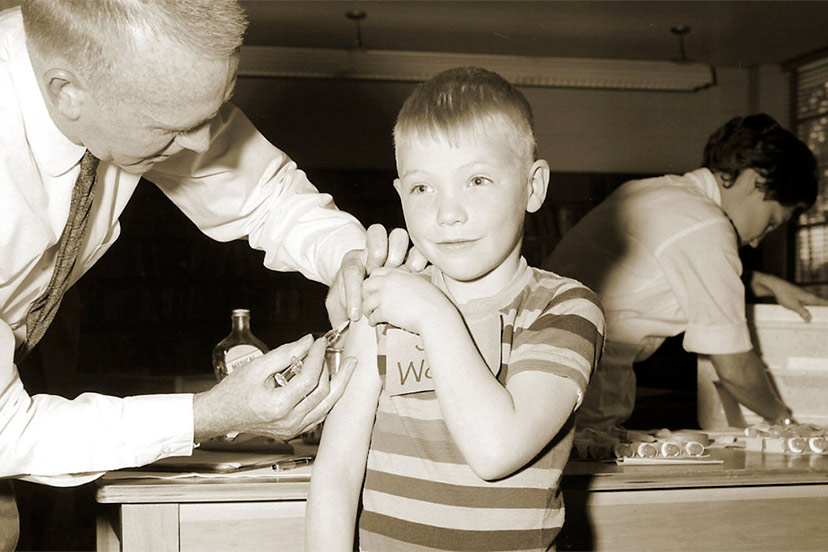Public health has been a ‘growth industry’ for a while now, although it got a huge boost from COVID.
When the SJBPH district was formed in 1947, the population of Archuleta County consisted of about 3,000 rural residents; La Plata County’s population was about 15,000. One of the first jobs undertaken was the vaccination of children. The whooping cough vaccine had been recently approved. The polio vaccine had not yet made an appearance; the measles vaccine was still a decade away.
Another public health need, in 1947, was the inspection of dairy farms, milk processing plants, and restaurants.
Initially, three other counties — Montezuma, Dolores and San Juan — were part of the San Juan Basin Health Unit (the organization’s original name). At some point, these other three counties each formed its own independent public health department. I’m not clear when, exactly, those changes took place.
We might imagine that the Health Unit staff consisted of a couple of full-time employees in 1947. But the public health landscape was about to change. The federally-funded public health programs that arose during the 1960s and 1970s — such as the the 1967 Comprehensive Health Planning Act — established a nationwide system of health planning agencies and allowed development of community health centers across the country.
By 2013, SJBPH was spending $4.6 million annually, most of it funded by federal and state contracts. That year, Archuleta County contributed only about $133,000 to the SJBPH budget. Our population in 2013 was about 12,000 residents — about four times the population in 1947. La Plata’s population had more than tripled, to about 52,000.
Our county population is now about 13,500, and La Plata’s is about 56,000. Next year, SJBPH expects to spend about $7.9 million; Archuleta County will contribute about $284,000 to that effort.
The staff at SJBPH now consists of more than 75 employees, according to the district website. I believe fewer than a half-dozen of those employees work full-time in Archuleta County, although a report last March by Executive Director Liane Jollon indicated that Archuleta County receives a per-capita share of SJBPH services roughly equivalent to what is provided in La Plata County.
As mentioned in Part Two of this editorial series, most Colorado counties — 47 out of 64 — operate a local, independent, county-funded and county-governed public health department.
Only 17 counties participate in shared, multi-county public health districts. Archuleta County has been one of those 17 counties, for the past 75 years… sharing the funding of, and the governance of, the San Juan Basin Public Health district with neighboring La Plata County.
We learned last week that La Plata County has allocated $750,000 in its 2023 budget to planning for its own independent public health department. County Manager Chuck Stevens described that amount as a “one-time expenditure” and thus, as an appropriate use of reserve funds. He also mentioned that La Plata County is working with consultants to plan their department.
I have not been able to locate any funding in the 2023 Archuleta County budget for planning or staffing an independent public health department, even though the BOCC has agreed to dissolve the shared SJBPH district on December 31, 2023.
You can download the dissolution agreement here.
The joint resolution to dissolve the district is one of two important documents approved by both BOCCs on November 15. The other document is an intergovernmental agreement (IGA) that specifies how the assets of SJBPH will be distributed between the two counties. For example, the “Real Property Situated in La Plata County, Building, Appurtenances, and Fixtures” will accrue to La Plata County, while the “Real Property Situated in Archuleta County, Building, Appurtenances, and Fixtures” will be owned by Archuleta County.
La Plata County will acquire six vehicles. Archuleta County will acquire two. Ownership of the computers and “technology assets” located in each county will be transferred to its home county. Records will be jointly owned, except that patient records will continue to belong to each individual patient, at least in theory.
You can download the IGA here.
During a recent conversation, with an acquaintance who has been following the developments at SJBPH much more closely than I have, it was suggested that this dissolution might be the best thing that could happen to the public health landscape in Archuleta County… considering the relatively limited influence our Archuleta County leadership has been able to exercise over the programs and policies of San Juan Basin Public Health. Over the past couple of decades, most of the government guidance for SJBPH has reportedly come from the La Plata commissioners.
The two counties are indeed different in some important ways, beyond simply their political leanings. The average age in La Plata County is 41 years; the average age in Archuleta Count is 50 years. The median household income in La Plata County is about $69,000; here in Archuleta County, it’s about $56,000.
These two differences might suggest a slightly different focus for each county’s health policies.
Other differences are suggested by the priorities on display in each county’s proposed 2023 budget.
Considering the difficulties faced by our businesses and governments in finding qualified employees willing remain in the community for more than a couple of months — the point at which they realize they really are not going to find an affordable home to live in — I would have thought the Archuleta BOCC would already be advertising for a health district director…
…Someone to oversee a challenging transition, and make sure the new health department is ready to hit the ground running on January 1, 2024.
No such position is listed among Archuleta County’s current job openings, nor is such a position mentioned in the County’s draft budget.

